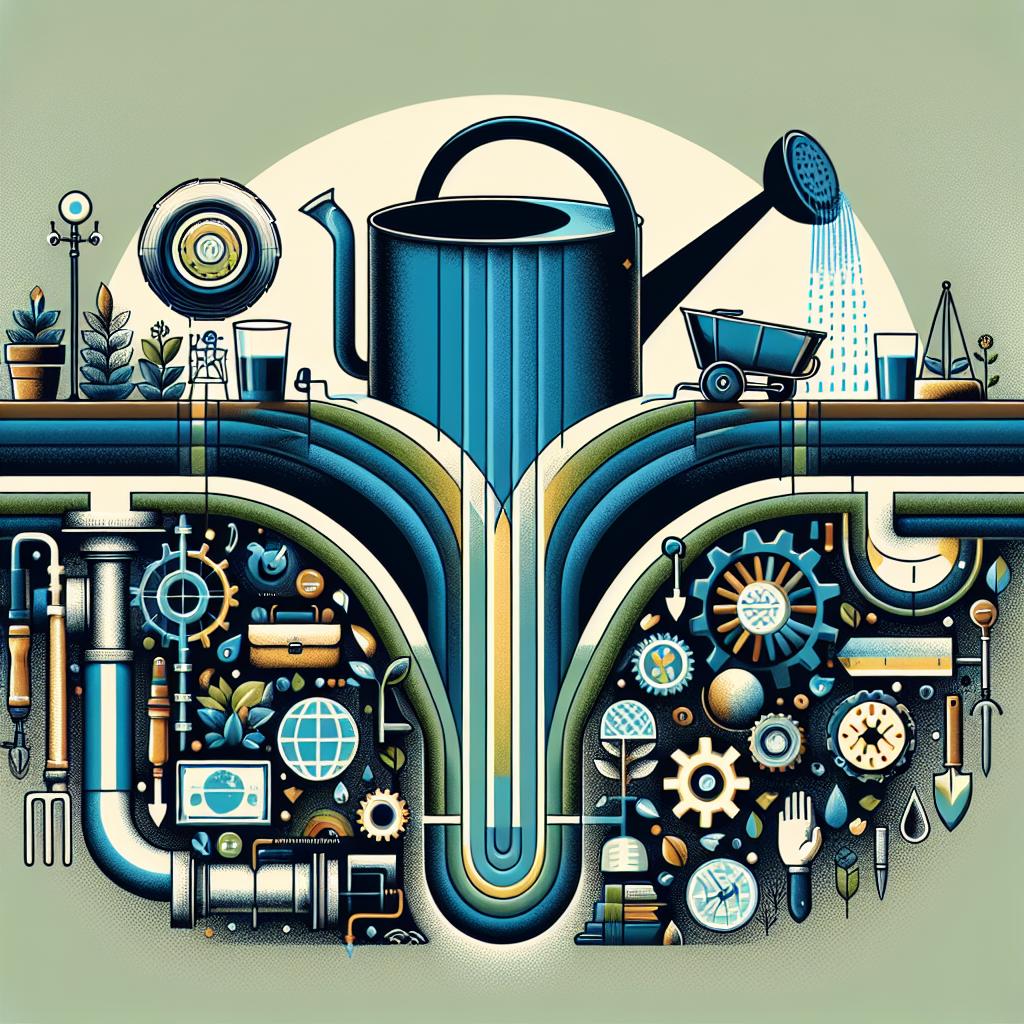This post may contain affiliate links which means I may receive a commission for purchases made through links. Learn more on my Private Policy page.
In the lush tapestry of agriculture, where the vibrant hues of crops dance under the sun, irrigation systems play a crucial role, weaving an intricate story of growth, quality, and market success. Imagine walking through fields of golden wheat swaying gently in the breeze or biting into a crisp,juicy apple fresh from the tree. Behind these delightful experiences lies a network of underground pipes, drip lines, and sprinklers, quietly working to nurture each plant to its fullest potential. as climate change challenges traditional farming practices and water scarcity looms, the meaning of effective irrigation becomes more pronounced than ever. In this article, we will explore how innovative irrigation systems not only enhance crop quality but also elevate marketability, ensuring farmers can reap the rewards of their hard work and consumers enjoy the freshest produce available. So, let’s dig in and discover the transformative power of water in the world of agriculture!
Understanding the Science of Irrigation: how Water Management Shapes Crop Quality
Water management in agriculture is more than just a necessity; it is a essential aspect that can significantly influence the quality and marketability of crops. Effective irrigation systems not only ensure even water distribution but also enhance crop resilience against diseases and pests. When crops receive the right amount of water at the right time, they demonstrate improvements in nutrient uptake, resulting in more robust plants and superior produce. Factors such as the timing of irrigation, the method used, and soil moisture levels all play crucial roles in determining how healthy the crops will be and how well they will perform in the marketplace.
Different irrigation techniques can lead to varying outcomes in crop quality. For example, drip irrigation, known for its efficiency, minimizes water wastage and directly nourishes the root zones, yielding fruits and vegetables that are consistently flavorful and nutritious. Conversely, traditional flood irrigation can lead to waterlogging or nutrient leaching, adversely affecting crop health and quality. The impact of irrigation on crop types can be summarized as follows:
| Irrigation Technique | Impact on Crop Quality | Marketability |
|---|---|---|
| Drip Irrigation | Enhanced flavor and nutrient retention | High demand, premium pricing |
| Sprinkler Irrigation | Even moisture distribution, moderate benefits | Standard pricing, variable demand |
| Flood Irrigation | Risk of uneven growth, potential for disease | Lower demand, price fluctuations |
the careful selection and management of irrigation systems can make all the difference in agricultural success. By understanding the science behind these practices, farmers not only secure a bountiful harvest but also bolster their products’ marketability, aligning quality with consumer expectations. Adjusting irrigation strategies according to crop requirements and environmental conditions is key to thriving in today’s competitive agricultural landscape.

Digging Deep: The Role of Irrigation Systems in Boosting Market Readiness
Effective irrigation systems play a critical role in enhancing the overall quality of crops, which directly influences their market readiness. By ensuring consistent moisture levels, these systems promote healthier plants that are less prone to stress and disease. when crops receive the right amount of water at the right time, they are better equipped to develop robust structures, vibrant colors, and optimal sizes, all of which appeal to consumers and retailers alike. Key benefits provided by advanced irrigation systems include:
- Uniform water Distribution: Reduces inconsistencies, leading to uniform growth rates.
- Efficient Water Use: Minimizes water wastage, making it environmentally pleasant.
- enhanced Nutrient Uptake: Promotes better absorption of nutrients, enhancing flavor and quality.
- Extended Growing Seasons: Facilitates growth in otherwise unsuitable conditions,allowing for off-season harvesting.
Marketability is also influenced by the aesthetics of the produce, and irrigation systems contribute significantly in this area. A well-watered crop frequently enough displays a vibrant appearance, leading to higher consumer preference and satisfactory market prices. Additionally, varied irrigation techniques, such as drip or sprinkler systems, can be tailored to specific crop needs, ensuring that farmers maximize yield while minimizing input costs. The differences can be striking when analyzed:
| system Type | Water Efficiency | crops Best Suited |
|---|---|---|
| Drip Irrigation | High | Vegetables, Orchards |
| Sprinkler Irrigation | Moderate | cereals, Pastures |
| Surface Irrigation | Low | Rice, Sugarcane |

Sustainable Practices: Enhancing Crop Quality Through Innovative Irrigation techniques
Innovative irrigation techniques are increasingly recognized as a cornerstone for improving crop quality while promoting sustainability in agriculture. By utilizing methods such as drip irrigation, rainwater harvesting, and soil moisture sensors, farmers can provide precise water delivery to plants, minimizing waste and ensuring optimal growth conditions. This targeted approach not only boosts the overall health of the crops but also enhances their resistance to pests and diseases. As a result, products cultivated through these advanced methods are often richer in flavor, texture, and nutritional value, making them more appealing to consumers and increasing their marketability.
Moreover, the adoption of these sustainable practices fosters a holistic approach to farming that addresses both environmental and economic challenges. For instance, practices such as integrated pest management and crop rotation can be enhanced through efficient irrigation, leading to higher yields without compromising soil health. A recent study highlights the correlation between modern irrigation systems and crop quality:
| Technique | Benefits |
|---|---|
| Drip Irrigation | Reduces water waste, increases yield |
| Rainwater Harvesting | Promotes water conservation, enhances soil quality |
| Soil Moisture Sensors | Optimizes water use, prevents over-irrigation |
By embracing these innovative irrigation techniques, farmers can not only enhance the quality of their crops but also meet the growing demand for sustainable and organic produce in the market. The ripple effect of these practices extends beyond individual farms as they contribute significantly to resource conservation, biodiversity, and the overall resilience of agricultural systems.

Harvesting Success: Practical Tips for Farmers to Optimize Irrigation and Maximize Market Appeal
Effective irrigation systems are not just about providing water; they play a crucial role in enhancing the overall quality of crops. By adopting precise irrigation techniques, farmers can significantly improve the taste, texture, and nutritional value of their produce. An optimal irrigation strategy helps in the prevention of water stress, ensuring that plants receive the right amount of moisture at the right time, which is essential during critical growth stages. Consider the following tips to harness the full potential of your irrigation methods:
- Monitor Soil Moisture: Use sensors or moisture meters to determine when irrigation is needed, helping to avoid over or under-watering.
- Implement Drip Irrigation: This method delivers water directly to the roots, reducing evaporation and runoff, leading to healthier plants.
- Schedule Wisely: Irrigate in the early morning or late evening to minimize water loss due to evaporation.
When crops are grown under optimized irrigation systems, they not only thrive but also become more appealing in the marketplace. High-quality produce tends to command better prices, making it essential for farmers to focus on their irrigation methods.To maximize market appeal, consider factors such as yield consistency and aesthetic quality. A simple comparison table below illustrates how irrigation impacts crop appeal:
| Crops | Traditional Irrigation | Optimized Irrigation | Market Appeal |
|---|---|---|---|
| Tomatoes | Inconsistent size, lower taste | Uniform size, rich flavor | High demand, better pricing |
| Grapes | Poor color, less sugar | Vibrant color, high sugar content | Premium market for wines |
| Leafy Greens | Brittle texture | Crisp and tender | Popular in fresh markets |
Insights and Conclusions
as we draw the curtain on our exploration of irrigation systems and their remarkable influence on crop quality and marketability, it’s clear that water—an essential resource—holds the key to unlocking the true potential of our agricultural endeavors. Much like a painter carefully selecting colors for their masterpiece,farmers wield irrigation tools to nurture and enhance the fruits of their labor. The journey of a seed from the soil to the marketplace becomes a story of growth, resilience, and change.
Embracing modern irrigation techniques not only cultivates lush fields but also ensures that farmers can meet the demands of an ever-evolving market filled with discerning consumers. As we continue to innovate and adapt, let’s celebrate the vital role that water management plays in our food systems, bringing forth not just bountiful harvests but also the promise of sustainability and prosperity.
So next time you savor the fresh flavors of your favorite produce, take a moment to appreciate the unseen hands of irrigation systems that have nurtured those crops to perfection.Together, let’s cultivate a future where our tables are plentiful, our farmers thrive, and our ecosystems flourish. Happy harvesting!
This post may contain affiliate links which means I may receive a commission for purchases made through links. Learn more on my Private Policy page.

